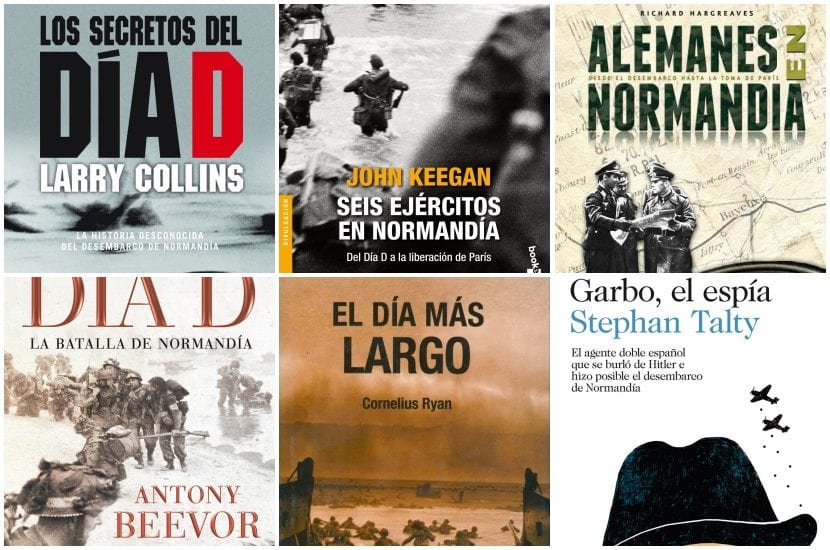
One more year, for all fans of Second World War, 6 June it is marked on the calendar as one of the most important dates of the conflict. This is already 74 who have passed. These 6 creative writing are to keep remembering that D-Day 1944, the landing of Normandy.
Six armies in Normandy - John Keegan
June 6, 1944, D-Day, has been marked in history as one of the key dates of the Second World War. It was a military milestone in which all the Allied armies participated and which marked the beginning of the end for the German military machine.
The landing on the beaches of Normandy was a practically perfect success, but another three months of fighting followed until the German defense was broken and Paris could be liberated. This book is a masterful account of one of the military campaigns most relevant in history.
John Keegan is one of the most prestigious British military historians and introduces the reader to the fighting in which the six armies that participated in the campaign were involved. Also in the tactical decisions of the commanders and in the traumatic experiences that the soldiers faced.
Germans in Normandy - Richard Hargreaves
This is the account of about 60.000 German soldiers, sailors and airmen who fell in the fighting for Normandy. Despite the regime they served, they fought bravely, and in many cases honorably, against an enemy that overwhelmingly outnumbered and outnumbered them.
It is narrated from letters, diaries, personal memories, stories, newspapers and documents of German officers and soldiers in Normandy. The other point of view that needs every story of a war.
D-Day - The Battle of Normandy - Antony Beevor
The almost classic classic for this date is this book by the famous British historian. Beevor writes us a long story rich in data on one of his favorite subjects, World War II. Here the detailed historical account is peppered with personal experiences that humanize it and give it the necessary dose of emotion. Beevor manages to perfectly combine that historical precision so common in his works with many testimonials from personal interviews and letters from real protagonists of battle.
The longest day - Cornelius Ryan
Dublin-born Ryan was an Irish-American journalist and also a writer especially known for his works on Military History. This book is considered by many the classic work of the Normandy landings. He tells us about the landing from a human point of view, relying again on a large number of testimonies.
Present a choral history from all perspectives and points of view, Ryan achieves an enjoyable and perfectly ordered story. Ryan also was screenwriter of the movie of the same name that was made in 1962. It was directed by Ken Annakin and had a luxury cast among which stand out John Wayne, Henry Fonda, Robert Mitchum, Sean Connery and Richard Burton. Its special effects and photography won two Oscars and it is also considered a classic of war cinema of all time.
The secrets of D-Day - Larry Collins
The American writer and journalist Larry Collins was the usual collaborator of the French Dominique Lapierre in the series of books shared by these authors. Here Collins told us this supposedly unknown story of the Normandy landings. With his well-known narrative ease, he recounts the important role of the secret services when it came to confusing Hitler, among which he highlighted the work of the Spanish spy Garbo.
Garbo, the spy - Stephan Talty
Talty has been an event reporter at the Miami Herald, and reporter . in Dublin and New York. In this book also develops the figure of Juan Pujol, or Garbo. It highlights him as one of the people who made the Allied victory in World War II a reality and whose story is so amazing, romantic and spectacular that it is hard to believe it is true.
Pujol He was born in Barcelona at the beginning of the XNUMXth century and from a very young age he proved to have wood for deception and he was also a fierce anti-Nazi. After the Spanish Civil War he offered himself as a double agent to the Allies. And so Pujol created, for the Nazi intelligence services, armies made of air, squadrons of ships that only existed in his head and a network of agents formed only by himself.
But his really great performance consisted in making the Germans believe that the D-day landing would take place in Calais and not in Normandy. That facilitated the Allied attack and the beginning of the end of the Second World War. When the conflict ended, and fearing reprisals from the surviving Nazis, Pujol fled Europe, faked his own death even for his family and rebuilt his life with another identity.